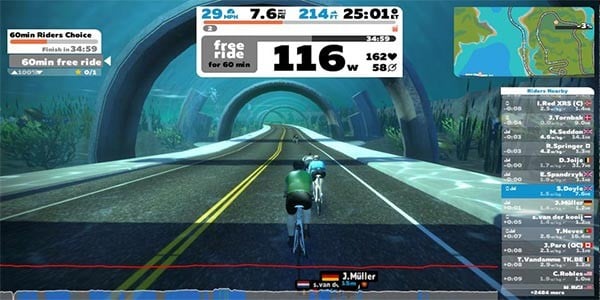Thanks to the introduction of smart trainers and interactive software, riding indoors has been revolutionised for many cyclists, from amateurs to pros alike, so that turbo training is no longer the dreaded, monotonous ordeal it used to be.
A smart trainer is different to a classic or “dumb” trainer in that it can be linked up to a computer, tablet or phone via bluetooth or ANT+, as well as taking advantage of Internet connectivity.
The trainer’s speed and resistance can then be understood and controlled by a software program, bringing into play a host of new possibilities when it comes to training indoors.
So, whether you’re considering investing in your first smart trainer, or you’ve recently got set up but aren’t quite sure how to get the most out of it, these tips should be right up your street.
Structured cycling workouts
One of the first ways a smart trainer can improve your training and fitness is allowing you to follow a programmed workout on screen, either one that’s pre-installed with your software or that you create yourself.
Within indoor training apps like Zwift and TrainerRoad, as well as wider cycling training software like TrainingPeaks, it’s possible to use drag and drop workout builders to create structured training sessions to follow along with.
Having a workout that’s made up of different intensities, durations etc will help you not only target and develop particular systems or abilities, but also does a lot to help you avoid the boredom that was previously associated with indoor training.
Using what’s called “ERG mode”, a feature that’s only recently become available with the advent of smart trainers, takes the concept of structured training even further.
ERG mode is where the trainer holds a given resistance and holds you to a certain power output, no matter what cadence (how many times you spin the cranks per minute) you pedal at, meaning you don’t have to concentrate hard to stay at the right intensity.
This results in accurate, precise workouts that avoid all the obstructions like cars, traffic lights etc that can get in the way out on the open road.
More social interaction
In the past, indoor training was largely a lonely affair, where cyclists training inside would have to battle through their workouts alone. Now that trainers can be linked up to the Internet and the possibility of riding in virtual worlds has become a reality through apps like Zwift, turbo training has become a much more social affair.
There are numerous benefits to training in a more social, group setting too…
One of these is accountability. When you have a ride organised and there are other riders to hold you to account if you don’t show up, it makes getting on the bike a lot easier. This also helps foster training consistency, one of the keys to long term improvement.
Another is that time often passes far quicker when training with a group . Years ago, turbo training would involve staring at a wall or at best trying to watch a movie or TV show, counting down the seconds and minutes until you were done.
Now, instead of watching the clock tick down, you can check out what other riders from around the world are up to and communicate through companion apps like Zwift Connect, whether by sending a “Ride On” to a fellow cyclist or engaging in a full-blown conversation.
This can be a great way to find new like-minded people to ride with regularly too, in both a virtual and real-world setting if they happen to be close by.
Regular online racing
Smart trainers have not only brought the ability to train effectively into your home, but also the opportunity to race and compete whenever you like for the first time too.
Much like a multiplayer video game allows you to enter tournaments via an Internet connection, apps like Zwift now offer the ability to enter regular races year-round. Simply fire up the Zwift Mobile App to find and join a race.
You can select the ideal ability level, which is based on your power to weight ratio at your Functional Threshold Power, as well as the type of race you want to do, be it a flat circuit race or a “hilly” route, which uses the resistance functionality of the smart trainers to simulate inclines and descents.
Some Zwift races even take the video game nature a step further by offering fun features like “power ups” (think Mario Cart), which can be activated by a touch of a key on a keyboard or via the Zwift Mobile App.

Virtual racing can do wonders for your training, whether you’re pressed for time or wanting to maintain high intensity training throughout the winter. Racing against others will help you to push harder and stray much further from your comfort zone than a regular training session, and when incorporated into a balanced training plan, will help improve both your fitness and motivation .
Higher power
One of the biggest limitations of turbo trainers and rollers in the past was the lack of resistance and control you had over the bike at higher power outputs, particularly with short, punchy intervals and sprinting.
Now, with most new smart trainers like the Wahoo KICKR, Elite Direto and the Tacx Neo using a “direct drive” design, where the bike attaches directly to the trainer without the need for a rear wheel, that’s largely no longer a problem…
These modern units can offer up to 2000W of resistance, allowing you to perform even shortest, most intense efforts without spinning out (i.e. running out of gears) or the rear wheel skipping around and losing power.
This helps you to perform better interval training (leading to bigger training adaptations), as well as the added benefit of saving you from buying new rear tyres on a regular basis, since the direct drive design does away with the friction-based method of older trainers.
Again, you can use ERG mode to pre-program these higher power intervals into your workouts and use the resistance of the trainer itself to overcome the need for a huge range of gears, meaning you do away with the need to shift up or down the cogs at all!
With smart turbo training still in a fairly early stage of development, it’ll be exciting to see what training advantages these units and software will offer in both the long and shorter-term future.














